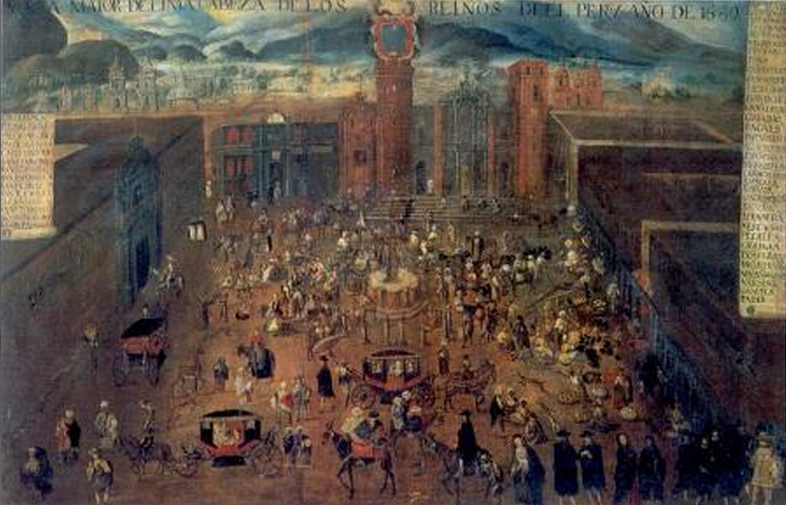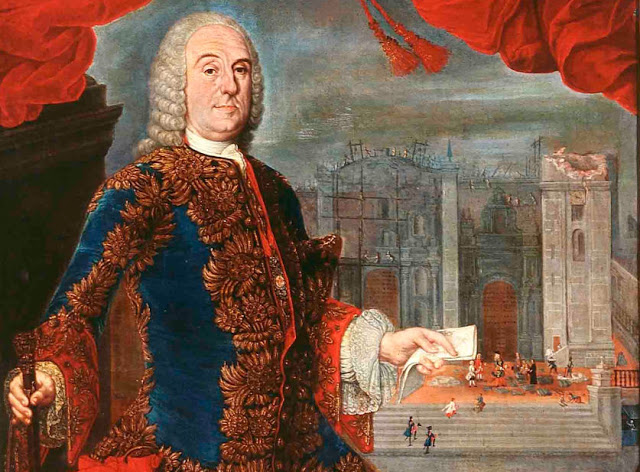
Lima in its Barroque splender at the end of the XVII century. Image from Juan Luis Orrego Penagos’ blog.
On October 28, 1746, the city of Lima was shaken by one of the strongest earthquakes in its history. Even though registries or scientific measurements for earthquakes didn't exist in that time period, by the descriptions that survived to the present day and the damage caused, it is estimated that the earthquake had a magnitude of 9 Mw.
The historian Juan Jose Pacheco Ibarra last year posted an article [es] in his blog Rincón de historia peruana (Corner of Peruvian History) using sources from that time period.
Se dice que las 4 de la tarde se levantó un viento caliente del nordeste, aparecieron nubes parduscas y densas.Era el viernes 28 de octubre de 1746, día de los Santos apóstoles San Simón y Judas, era una noche de luna llena.A las diez y media de la noche se inició un gran terremoto que destruyó la ciudad de Lima y ocasionó un maremoto en el Callao. El sismo duró entre tres y seis minutos.
It is said that at 4 in the afternoon a hot wind rose up from the northeast, and dark and dense clouds appeared.It was on Friday, October 28, 1746, the day of Simon and Judas, the apostle saints, and it was the night of a full moon.At 10:30 at night a great earthquake started that destroyed the city of Lima and caused a tsunami in Callao. The quake lasted between three and six minutes.
Pacheco continues relating the damage in the city:
Luego del terremoto en Lima solo quedaron en pie 25 casas de las tres mil que existieron. Todo se destruyó. Los edificios más importantes también fueron severamente afectados. El palacio del virrey, la catedral perdió una de sus torres que cayó sobre la bóveda de la iglesia destruyéndola. El local de la inquisición y la universidad de Lima (NdE: Universidad de San Marcos) quedaron severamente afectados.Las iglesias de San Agustín, La Merced y San Pablo donde cayeron las dos torres también fueron seriamente dañadas.Varios sectores de la muralla de Lima fueron destruidos. Algunos baluartes que quedaron en pie fueron usados como refugio de la población frente a las réplicas.En el hospital de Santa Ana 60 enfermos fueron sepultados por los techos mientras permanecían en sus camas.El convento del Carmen bajo sepultó a varias monjas.El famoso arco triunfal que se encontraba a la entrada del puente de piedra fue afectado por el sismo, la escultura ecuestre de Carlos V cayó al suelo y se destruyó.
After the earthquake in Lima, only 25 houses out of the three thousand that existed were still standing. Everything was destroyed. The most important buildings were also severely affected. The viceroy's palace, the cathedral lost one of it's towers which fell over the church's cupola, destroying it. The inquisition's building and the University of Lima (University of San Marcos) were severely affected.The San Agustin and La Merced churches, and the San Pablo church where the two towers fell, were also severely damaged.Several areas of the Lima city walls were destroyed. Some bastions that remained standing were used as refuge for the population facing aftershocks.At the Santa Ana hospital, 60 ill people were buried by the roofs while they stayed in their beds.Several nuns were buried beneath the Carmen convent.The famous arch of triumph that was located at the entrance to the stone bridge was affected by the quake, and the equestrian sculpture of Charles V fell to the floor and was destroyed.
Percy Taira, in the blog Expediente Oculto (Hidden Record), reproduces parts of a written chronicle by Father Pedro Lozano, from the Compañía de Jesús (Society of Jesus), who was a witness to the earthquake and narrates the great destruction in Lima, and adds [es] information about the tsunami that devastated Callao after the earthquake:
Pero fue incomparablemente mayor el daño en el Puerto del Callao, donde en la misma hora se sintió el terremoto sumamente violento. Resistieron á su primer ataque algunas torres, y una parte de las murallas; pero media hora después, comenzando los habitantes á respirar y recobrarse, se entumeció el mar, se elevó á una prodijiosa [sic] altura y se precipitó con horrible estruendo sobre la tierra, sumergiendo los mas grandes Navios, que se hallaban en el puerto; y elevando algunos por encima de las murallas y torres, los llevó á varar mas adelante de la población (…) No se distingue el lugar donde estuvo la ciudad, sino por las dos grandes puertas y algunos grandes lienzos de la muralla, que todavía subsisten
But there was incomparable damage in the Port of Callao, where the extremely violent earthquake was felt in the same hour. Some towers resisted its first attack, and a part of the walls; but half an hour after, when the inhabitants were starting to breathe and recover, the sea rose, it rose to an incredible height and it was precipitated by a loud noise over the ground, submerging the largest ships that were in the harbor, and lifting some others above the walls and towers, it carried them beyond the town (…) it is impossible to distinguish the place where the city used to be, expect for the two large doors and some large wall paintings that still exist.
The historian Juan Luis Orrego Penagos also comments [es] on the impact that this earthquake had on Lima's architecture:
las mejores joyas arquitectónicas de Lima se desintegraron; asimismo, tanto los edificios reconstruidos como los nuevos perdieron la elegancia y boato que mostraban los desaparecidos. En el futuro, como lección del siniestro, se empleó a gran escala el adobe, la quincha y los materiales ligeros, en reemplazo de la piedra, el ladrillo y los “materiales nobles”.
The best architectural gems of Lima disintegrated; at the same time, both reconstructed buildings and new ones lost the elegance and showiness displayed by those that disappeared. In the future, as a lesson of the incident, adobe, thatch, and light-weight materials were used on a large scale, replacing stone, brick and “noble materials”.
And the earthquake also had an affect on the virreynal city's habits , where, according to a study by the historian Scarlet O’Phelan, it was popularly believed that the earthquake occurred because of offenses the Lima people practiced, among them injustices against the poor, greed and usury, lust and women's vanity with their scandalous dresses.
En efecto, la iglesia sugirió que la moda francesa femenina de pronunciados escotes, mangas cada vez más cortas y faldas a la altura del tobillo, habían provocado la ira divina, materializada en el movimiento telúrico. La insinuante moda francesa había sido adoptada por las clases altas, pero también por los sectores populares.
Indeed, the church suggested that pronounced French fashion, including female necklines, increasingly shorter sleeves, and skirts above the ankle, sparked divine anger, embodied in the quake. The flirtatious French style was adapted by the upper classes, but also by everyday people.
In the blog Terremotos en la historia del Peru (Earthquakes in Peru's History), they point out [es] the relationship of this earthquake to the cult Lord of Miracles [en], and that even though it has indigenous origins [es] in its similarity with the cult Lord of Pachacamac, during the colony it was assimilated by black slaves and who made it their own. In the blog they point out that the earthquake “didn't only crack the physical foundations of Lima's buildings, but also political ones, since the black population rose in revolts and looting that altered the social order, as this natural punishment was interpreted as the harbinger of the viceroy's fall.”
“En octubre de 1747 se celebraron en la ciudad de Lima una serio de actos religiosos, entre los que destaco la procesión del Señor de los Milagros. Esta imagen recorrió por primera vez las calles de la ciudad durante cinco días. Es evidente que la procesión se ligó directamente por recuperar el orden público (…)” Rosas 2005:109
Esta acción tuvo buenos resultados para el gobierno ya calmo en cierta medida los ánimos entre la población revoltosa, además de convertirse el mes de octubre en una ocasión especial en donde se refuerza y recuerda los movimientos sísmicos en una estrecha vinculación a las relaciones sociales, tal y como lo vivimos en nuestros días.
“In October of 1747 a series of religious acts were celebrated in the city of Lima among which the Lord of Miracles procession was a highlight. For the first time this image traveled through the streets of the city for five days. It is clear that the procession was directly used to regain public order (…)” Rosas 2005:109
This action had good results for the government and somewhat calmed tempers among the unruly population, in addition to making the month of October a special occasion in which earthquakes help to strengthen and to remind us of our social ties, like we live these days.
It's worth adding that to this very day every October 28 the Lord of Miracles procession is seen through the streets of Lima.

Virrey José Antonio Manso de Velasco. Here is seen the side of the Lima Cathedral in the process of being rebuilt. For his great work he would receive the title of “Count of Superunda”. Image from the Rincón de Historia Peruana (Corner of Peruvian History) blog.
Rebuilding Lima took years, and was for the most part rebuilt thanks to the efforts of Viceroy Manso de Velasco, known then as Count of Superunda. Juan Jose Pacheco Ibarra comments:
El virrey Manso de Velasco actuó de manera casi inmediata comisionando a los empleados de limpieza y la cofradía de la caridad para dar sepultura a las víctimas […además] organizó la reconstrucción de los canales de agua, de los hornos de pan, la limpieza de escombros de las calles y de los caminos y la reconstrucción del palacio de los virreyes y la catedral.
Viceroy Manso de Velasco acted almost immediately commissioning cleaning employees and the charity brotherhood to bury victims […in addition] he organized the rebuilding of water canals, of bread ovens, cleaning debris from streets and roads and the rebuilding of the viceroy palace and the cathedral.
Additional information may be found on José Antonio Benito's blog, who shares [es] an interview with the North American historian Charles Walker, related to his book “Shaky Colonialism: The 1746 Earthquake-Tsunami in Lima, Peru, and Its Long Aftermath.” The book's presentation is available in this video [es] on YouTube.







1 comment
you should also add that days before the
earthquake flashes of “fire” could be seen over the sea in the air.
Now it is known that during an
earthquake the sky can be illuminated by the energy that is freed
this 1746 earthquake was so big that the
lights in the sky could be seen DAYS before!